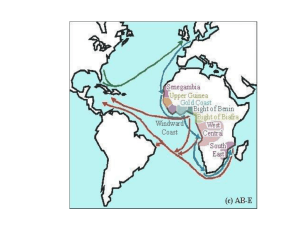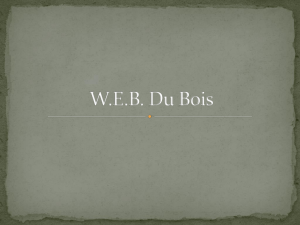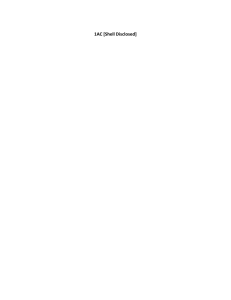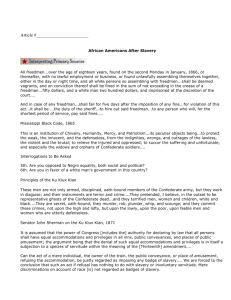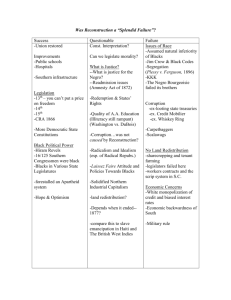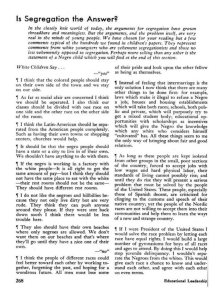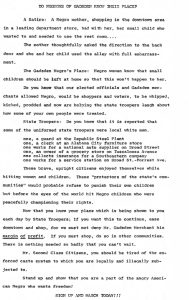1ac GeorgeJonathan
advertisement
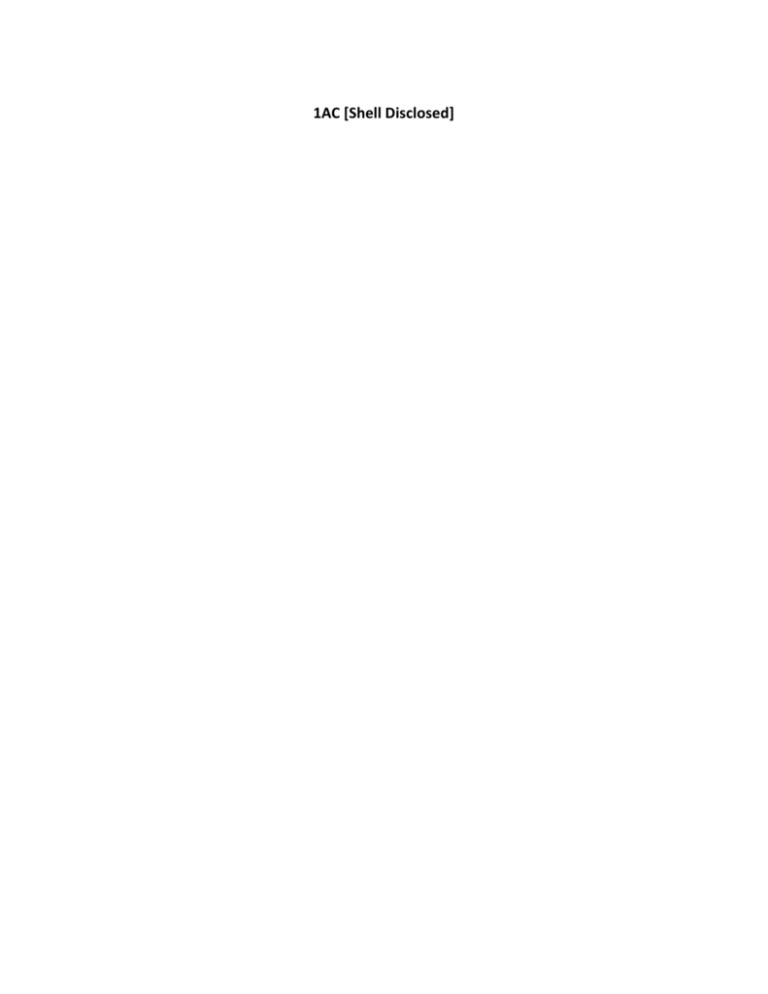
1AC [Shell Disclosed] Contention 1 –Policing The Color Line Modern Fugitive Slave Code This year’s resolution calls for a conversation of surveillance in the United States as it relates to its citizens; we begin our conversation at the ‘white gaze’ as an essential concept within federal government surveillance of bodies as they are reduced to their surfaces stereotypes because surveillance is a form of hegemony, grounded in material relationship of white power Yancy 2013(Walking While Black in the ‘White Gaze’ George Yancy September 1, 2013 Ph.D., Philosophy, Duquesne University, 2005 M.A., Africana Studies, New York University, 2004) Black bodies in America continue to be reduced to their surfaces and to stereotypes that are constricting and false, that often force those black bodies to move through social spaces in ways that put white people at ease. We fear that our black bodies incite an accusation. We move in ways that help us to survive the procrustean gazes of white people. We dread that those who see us might feel the irrational fear to stand their ground rather than “finding common ground,” a reference that was made by Bernice King as she spoke about the legacy of her father at the steps of the Lincoln Memorial. The white gaze is also hegemonic, historically grounded in material relations of white power: it was deemed disrespectful for a black person to violate the white gaze by looking directly into the eyes of someone white. The white gaze is also ethically solipsistic: within it only whites have the capacity of making valid moral judgments. Even with the unprecedented White House briefing, our national discourse regarding Trayvon Martin and questions of race have failed to produce a critical and historically conscious discourse that sheds light on what it means to be black in an antiblack America. If historical precedent says anything, this failure will only continue. Trayvon Martin, like so many black boys and men, was under surveillance (etymologically, “to keep watch”). Little did he know that on Feb. 26, 2012, that he would enter a space of social control and bodily policing, a kind of Benthamian panoptic nightmare that would truncate his being as suspicious; a space where he was, paradoxically, both invisible and yet hypervisible. “I am invisible, understand, simply because people [in this case white people] refuse to see me.” Trayvon was invisible to Zimmerman, he was not seen as the black child that he was, trying to make it back home with Skittles and an iced tea. He was not seen as having done nothing wrong, as one who dreams and hopes. As black, Trayvon was already known and rendered invisible. His childhood and humanity were already criminalized as part of a white racist narrative about black male bodies. Trayvon needed no introduction: “Look, the black; the criminal!” Many have argued that the site of violence occurred upon the confrontation between Trayvon and Zimmerman. Yet, the violence began with Zimmerman’s nonemergency dispatch call, a call that was racially assaultive in its discourse, one that used the tropes of antiblack racism. Note, Zimmerman said, “There’s a real suspicious guy.” He also said, “This guy looks like he’s up to no good or he’s on drugs or something.” When asked by the dispatcher, he said, within seconds, that, “He looks black.” Asked what he is wearing, Zimmerman says, “A dark hoodie, like a gray hoodie.” Later, Zimmerman said that “now he’s coming toward me. He’s got his hands in his waist band.” And then, “And he’s a black male.” But what does it mean to be “a real suspicious guy”? What does it mean to look like one is “up to no good”? Zimmerman does not give any details, nothing to buttress the validity of his narration. Keep in mind that Zimmerman is in his vehicle as he provides his narration to the dispatcher. As “the looker,” it is not Zimmerman who is in danger; rather, it is Trayvon Martin, “the looked at,” who is the target of suspicion and possible violence. AND, the events that transpired between Zimmerman and Trayvon are not a drop in the bucket, surveillance has a long history of anti-black racism which is inherent to the policy making that creates the conception of ‘the criminal’–Laws such as Stop and’ frisk Browne 2012(Everybody’s got a little light under the Sun Simone Browne is Assistant Professor in the Departments of Sociology and African and African Diaspora Studies at the University of Texas at Austin 06 Jan 2012) ‘Moment by moment’ is the experience of surveillance in urban life, as David Lyon observes, where the city dweller expects to be ‘constantly illuminated’ (2001, p. 51–53). It is how the city dweller contends with this expectation that is instructive. To examine closely the performance of freedom, a performative practice that I suggest that those named fugitive in the Board of Inquiry arbitration hearings made use of, I borrow Richard Iton's ‘visual surplus’ and its b-side ‘performative sensibility’ (2009, p. 105). What Iton suggests is that we come to internalize an expectation of the potential of being watched and with this emerges a certain ‘performative sensibility’. Coupled with this awareness of an overseeing surveillance apparatus was ‘the conscious effort to always give one's best performance and encourage others to do the same, and indeed to perform even when one is not sure of one's audience (or whether there is in fact an audience)’ (p. 105). Iton employs the term visual surplus to think about the visual media of black popular culture (graffiti, music videos) made increasingly available to the public through the rise of hip-hop in the five boroughs of New York City in the 1970s and the uses of new technologies (cellular phones, handheld cameras, the Internet, DVDs) to record and distribute performances. Applied to a different temporal location, Iton's analyses of visual surplus and performative sensibility are useful for how we think about fugitive acts, black expressive practices and the regulation of black mobilities in colonial New York City 200 years earlier. What I am suggesting here is that for the fugitive in eighteenth century New York such a sensibility would encourage one to perform – in this case perform freedom – even when one was not sure of one's audience. Put differently, these performances of freedom For the black subject, the potentiality of being under watch was a cumulative effect of the large scale surveillance apparatus in colonial New York City and beyond stemming from transatlantic slavery, specifically fugitive slave posters and print news advertisements, blackbirders and other were refusals of dispossession, constituting the black subject not as slave or fugitive, nor commodity but as human . freelancers who kidnapped free blacks to transport them to other sites to be enslaved, slave catching and through the passing of repressive black codes, such as those in response to the slave 1712 saw an armed insurrection in New York City where over two dozen black slaves gathered in the densely populated East Ward of the city to set fire to a building, killing at least nine whites and wounding others. In the end over 70 were arrested, with many coerced into admissions of guilt. Of those, 25 were sentenced to death and 23 of these death sentences were carried out. Burned at the stake, hanged, beheaded and their corpses publicly displayed and left to decompose, such spectacular corporal punishment served as a warning for the city's slave population and beyond. With these events and the so-called slave conspiracy to burn the city in 1741, the black code governing black city life consolidated previously enacted laws that were enforced in a rather discretionary fashion.6 Some of these laws spoke explicitly to the notion of a visual surplus and the regulation of mobility by way of the candle lantern. On 14 March 1713, the Common Council of New York City passed a ‘Law for Regulating Negro or Indian Slaves in the Nighttime’ that saw to it that ‘no Negro or Indian Slave above the age of fourteen years do presume to be or appear in any of the streets’ of New York City ‘on the south side of the fresh water one hour after sunset without a lantern or a lit candle’ (New York Common Council, Volume III). ‘Fresh water’ here referring to the Fresh Water Pond found in lower Manhattan, slightly adjacent to the Negroes Burial Ground and that supplied the city with drinking water at the time. Again, this law regulating mobility and autonomy through the use of the technology of the candle lantern was amended on 18 November 1731 where ‘no negro, mulatto or Indian slave above the age of fourteen years’ unless in the company of some white person ‘or white servant belonging to the family whose slave he or she is, or in whose service he or she there are’ was to be without a light that could be plainly seen or it was then ‘lawful for any of his Majesty's Subjects within the said City to apprehend such slave or slaves’ Any slave convicted of being unlit after dark was sentenced to a public whipping of no more than 40 lashes, at the discretion of the master or owner before being discharged. Later this punishment was reduced to no more than 15 lashes. Such discretionary violence made for an imprecise mathematics of torture. Mostly, punishment for such transgression was taken into the hands of the slave owner. In 1734 a male slave of John van Zandt was found dead in his bed. The dead man was said to have ‘absented himself’ from van Zandt's dwelling in the night-time (New York Weekly Journal CXIII, 5 January 1735). Although it was first reported that the slave was horsewhipped to death by Van Zandt for being caught on the streets after dark by watchmen, a coroner's jury found Van Zandt not negligent in this death, finding instead that ‘the correction given by the Master was not the cause of death, but that it was by the visitation of God’ (New York Weekly Journal CXIII, 5 January 1735). Other laws put into place around light and black mobilities in New York City stipulated that at least one lantern must be carried per three negroes after sunset, more tightly regulated curfews and in 1722 the Common Council relegated burials by free and enslaved blacks to the daytime hours with attendance of no more than 12, insurrection of 1712. April and ‘carry him, her or them before the Mayor or Recorder or any of the Aldermen of the said City who are hereby authorized upon proof of offense to commit such slave or slaves to the Common Gaol’ (New York Common Council, Volume IV). plus the necessary pallbearers and gravediggers, as a means to reduce opportunities for assembly and to prevent conspiracy hatching. In recounting physician Alexander Hamilton's narrative about his travels through New York City in July of 1744, Andy Doolen details that one outcome of the alleged conspiracy of 1741 was the ruining, according to Hamilton, of the traditional English cup of tea (2005). It was thought by Hamilton that: They have very bad water in the city, most of it being hard and brackish. Ever since the negroe conspiracy, certain people have been appointed to sell water in the streets, which they carry on a sledge in great casks and bring it from the best springs about the We can think of the lantern as a prosthesis made mandatory after dark, a technology that made it possible for the black body to be constantly illuminated from dusk to dawn, made knowable, locatable and contained within the city. The black body, technologically enhanced by way of a simple device made for a visual surplus city, for it was when the negroes went for tea water that they held their caballs and consultations, and therefor they have a law now that no negroe shall be seen upon the streets without a lanthorn after dark. (Hamilton 1948, p. 88) where technology met surveillance, made the business of tea a white enterprise and encoded white supremacy, as well as black luminosity, in law. Of course, unsupervised leisure, labour, travel, assembly and other forms of social networking past sunset by free and enslaved black New Yorkers continued regardless of the enforcement of codes meant to curtail such things. Policing manifest itself via different yet similar instances of racist violence, Stop and Frisk policies are amongst many technologies of surveillance the “Police State” operates under to disiminate white supremacy –The criminalization of black and brown bodies is neither abstract or hypothetical the 1AC is a necessary starting point to analyze this Nikhil Pal Singh. Associate Professor of Social and Cultural Analysis , History ; SCA Director of Graduate Studies Yale University, PhD 1995. “The Whiteness of Police.” American Quarterly, Volume 66. December 2015. It is perhaps facile to equate “the beat” that marked out the geography of the slave patrol with the modern patrolman’s beat. Still, former New York City police commissioner Raymond Kelley (at one time a candidate for director of Homeland Security) defended the racially disproportionate policy of stop and frisk on the grounds that it “instills fear” in the city’s criminal element. Encouaged by a “statistics based performance management system,” the NYPD has conducted a staggering 4 million stops and some 2.3 million frisks since 2004. More than 81 percent of these targeted the city’s black and Latino residents. Only 1.5 percent of these police actions resulted in the discovery of a weapon and only 6 percent of all stops resulted in arrest. Judge Shira A. Sheindlin, who ruled against the city’s defense of this policy (before being removed from the case herself ), notes that “the racial composition of the precinct or census tract predicts the stop rate above and beyond the crime rate” and that the popula- tion stopped and frisked is “overwhelmingly innocent.”18 Policing what comes to be denoted as crime—from mild correction to jus- tifiable homicide—was the essence of The long arc of criminalizing blackness in particular helps us to recognize racial distinction as the obscured mode of institution of society that has been retained across changes in formal racial categories and degrees of inclusion. If white supremacy is understood as a form of group-differentiated power and pleasure that accrues value, the racial slave and frontier law. distribution and directionality of the legitimate violence it exerts over those regarded as “dangerous and inconvenient” publicly confirms it and performs its most essential work. “The majority of Negroes are of a plot- ting disposition, dark, sullen, malicious, revengeful, and cruel in the highest degree,” Benjamin Franklin notes toward the end of his life, this time without qualification. The routine police murder of black men and women from Amadou Diallo to Renisha McBride and Michael Brown in our own time demonstrates its continuous legacy. When President Barack Obama’s attorney general Eric Holder recently defended juridically Despite his growing abolitionist sympathies, Franklin doubted that “mild laws could govern such a people,” which is to say that he affirmed the whiteness of police.19 indefensible targeted killing by drone—a practice whose collateral victims include those engaging in forms of feasting and funerary sociality—by likening it to the exigencies of the police who not unreasonably “prevent escape by using deadly force,” he once again extends its sway to the ends of the earth. Surveillance is used as a silencing tool against black movements Joseph 15, 7-24-2015, reporter, "Exclusive: Feds Regularly Monitored Black Lives Matter Since Ferguson," The Intercept, https://firstlook.org/theintercept/2015/07/24/documents-show-departmenthomeland-security-monitoring-black-lives-matter-since-ferguson/ The Department of Homeland Security has been monitoring the Black Lives Matter movement since anti-police protests erupted in Ferguson, Missouri last summer, according to hundreds of documents obtained by The Intercept through a Freedom of Information Act request. The documents, released by the Department of Homeland Security’s Office of Operations Coordination, indicate that the department frequently collects information, including location data, on Black Lives Matter activities from public social media accounts, including on Facebook, Twitter, and Vine, even for events expected to be peaceful. The reports confirm social media surveillance of the protest movement and ostensibly related events in the cities of Ferguson, Baltimore, Washington, DC, and New York. They also show the department watching over gatherings that seem benign and even mundane. For example, DHS circulated information on a nationwide series of silent vigils and a DHS-funded agency planned to monitor a funk music parade and a walk to end breast cancer in the nation’s capital. The tracking of domestic protest groups and peaceful gatherings raises questions over whether DHS is chilling the exercise of First Amendment rights, and over whether the department, created in large part to combat terrorism, has allowed its mission to creep beyond the bounds of useful security activities as its annual budget has grown beyond $60 billion. The surveillance cataloged in the DHS documents goes back to August of last year, when protests and riots broke out in Ferguson the day after the shooting of unarmed black teenager Michael Brown. According to two August 11th, 2014 reports, a DHS FEMA “WatchOps officer” used information from Twitter and Vine to monitor the riots and reproduced a map, originally created by a Reddit user, of conflict zones. This sort of information gathering was not confined to Ferguson. A few days after rioting and protests there, a DHS email forwarded another message reporting on the “National Moment of Silence,” nationwide silent vigils planned in response to the shooting. The original email listed the cities with planned vigils and noted that they were being spread on social media with the hashtag #NMOS14. It also mentioned that NYPD’s counterterrorism intelligence organization would be “monitoring the situation.” The DHS email forwarding that information said the data was provided “for your situational awareness.” An April 2015 FEMA memo also shows that the DHS appears to have gathered information on anti-police-brutality protests in Philadelphia “organized by members of the Philly Coalition for Real Justice” and in New York on May Day at “Foley Square, start time 1700… Independent factions are being solicited to join in on a full day of demonstration through various open source social media sites, fliers, posters.” In an email to The Intercept, DHS spokesman S.Y. Lee wrote: “The Department of Homeland Security fully supports the right of individuals to exercise their First Amendment rights and does not provide resources to monitor any specific planned or spontaneous protest, rally or public gathering. The DHS National Operations Center statutory authority (Section 515 of the Homeland Security Act (6 U.S.C. § 321d(b))) is limited to providing situational awareness and establishing a common operating picture for the federal government, and for state, local, tribal governments as appropriate, in the event of a natural disaster, act of terrorism, or other man-made disaster, and ensures that critical terrorism and disaster-related information reaches government decision-makers.” Baher Azmy, a legal director at the Center for Constitutional Rights, however, argues that this “providing situational awareness” is just another word for surveillance and that creating this body of knowledge about perfectly legal events is a problem in and of itself. “What they call situational awareness is Orwellian speak for watching and intimidation,” said Azmy. “Over time there’s a serious harm to the associational rights of the protesters and it’s an effective way to chill protest movements. The average person would be less likely to go to a Black Lives Matter protest if the government is monitoring social media, Facebook, and their movements.” Although Lee says in his email that the department “does not provide resources to monitor any specific planned or spontaneous protest, rally or public gathering,” some of the documents show that the DHS has produced minute-by-minute reports on protesters’ movements in demonstrations. Surveillance and illegal searches are interchangeable when it comes to groups not believed to be citizens of this country, America’s genocidal consensus sutures its policy making hence its obvious that its mission isn’t towards the dismantling of racism but its continual restructuring of it Cacho 12 (Lisa Marie Cacho, Social Death: Racialized Rightlessness and the Criminalization of the Unprotected, Accessed 7/14/15, Published 2012, https://muse.jhu.edu/books/9780814723777?auth=0) evaluative when a group’s rights are not socially recognized, discussions revolve around whether or not the aggrieved group even deserves to speak out against discrimination or exploitation, which effectively subverts or forecloses any dialogue about the actual injustices. Such debates concentrate on the deservingness of the population itself, as well as on whether or not the injured group should be allowed to voice grievances against unjust treatment. In so doing, they avoid discussing appropriate remedies or penalties to address the injustices. As a result, the fact that certain institutions and individuals have assumed they have the power to discriminate or exploit disempowered others is rarely called into question or up for debate. Feather’s analytical distinction between deservingness and entitlement is useful for thinking about why some groups’ rights are automatically recognized while others have to demonstrate they deserve them.New York Times own global worldliness American When people are presumed entitled to protection, rights are naturalized as properties of personhood. But for populations ineligible for personhood, those same “inalienable” rights can be called into question or even outright denied, thereby compelling people to prove they are indeed deserving. In his work on the social psychology of justice, scholar Norman T. Feather sug- gests that we consider the subtle distinctions between “entitlement” and “deservingness” to explain why only some demands for justice seem subject to evaluation. Entitlement, he writes, is grounded within a group’s “socially recognized rights.”107 Deservingness, on the other hand, “pertains to the structure of actions and their outcomes.”108 In other words, deservingness and entitlement have different frames of reference, which determine how legitimacy and credibility are assigned. Thus, when a group’s rights are presumed to be entitlements, discussions about injustice can focus on whether people’s rights have been respected. But At the same, though, this distinction needs to be slightly nuanced to account for the ways in which the entitlement to rights in the United States has been racialized as white and legally protected as such.109 Ironically, calling upon African Americans to claim ownership of “civil rights” (both the term and the history) requires African Americans to emphasize that their entitlement to rights was earned. Therefore, black entitlement to rights is essentially renarrated or represented as premised upon deservingness, rather than taken for granted like white entitlement to rights and personhood. In the following example, the constructed African Americans’ rights not as “socially recognized rights” but as rights that were earned through mass suffering and social protest. But despite some sympathy for the nation’s illegal immigrants, many black professionals, academics and blue-collar workers feel increasingly uneasy as they watch Hispanics flex their political muscle while assuming the mantle of a seminal black struggle for justice. Some blacks bristle at the comparison between the civil rights move- ment and the immigrant demonstrations, pointing out that black protesters in the 1960s were American citizens and had endured centuries of enslave- ment, rapes, lynchings and discrimination before they started marching. Others worry about the plight of low-skilled black workers, who some- times compete with immigrants for entry-level jobs. And some fear the unfinished business of the civil rights movement will fall to the wayside as America turns its attention to a newly energized Hispanic minority with growing political and economic clout.110 Because the journalist’s informants are expected to recount civil rights history in relation to immigrants’ demonstrations, they are already posi- tioned to remember and rehearse black entitlement to rights as deserved be- cause it was earned.111 Representing rights as a property of U.S. citizenship, even when those rights are denied, functions to construct the struggle for political inclusion as a right of citizenship rather than as a response to its denial. When the right to demand rights is imagined as an attribute or a property of U.S. citi- zenship, it emphasizes the “law” and “legal recognition” as the appropriate means for achieving social justice. This positions the state as the guarantor and administrator of justice even though it is the state that engendered the conditions conducive to violence and exploitation in the first place by either denying or refusing to recognize marginalized groups’ rights to personhood. Moreover, the legal recognition of a population’s personhood is thereby cast as the end point of struggle, whereas an aggrieved group’s humanity is the premise of resistance, not its goal. Furthermore, when U.S. citizenship is assumed to be a prerequisite for civil rights, African American activisms are detached from their histories as part of the 1950s–1970s struggle for personhood, decolonization, and sovereignty. As ethnic studies and queer studies scholar Chandan Reddy elab- orates, the move to represent civil rights as only for citizens’ is a current neoconservative ideology that exclusively highlights legal redress in order to efface rhetorically the of the civil rights movement, turning that movement into an exceptionalist drama of the na- tion’s repeated betrayal of black equality. In this latter ideology and rhetor- ical argument, that betrayal typically has been manifested and imagined as a contest between “immigrants” and “African Americans” for social mobil- ity in civil society.112 As Reddy notes, locating civil rights history as part of the American ex- ceptionalist drama scripts both that particular historical moment (1950s– 1970s) and our own (in the early decades of the twenty-first century) as related incidents of state betrayal. The failure to confer civil rights and the threat to grant immigrant rights are both represented as evidence for the state’s failure to protect its African American citizens, which undercuts com- peting interpretations of social movement history that see civil rights and immigrant rights as allied struggles. If we recognize that the United States was not the only site of social justice struggles and that legal recognition was not the only goal of the 1960s rights movements, we can set aside the notion that rights are contingent (with citizenship as the prerequisite) and conditional (with deservingness as the proviso). Throughout the 1950s, 1960s, and 1970s, movement leaders both inspired and were inspired by the movements for social justice and national independence worldwide. In fact, juxtaposing the immigrant rights move- ment with other forms and fronts of black social activism in the 1960s could avoid framing the contemporary moment in racial and relational terms as “us or them” or in Mitchell’s terms of “debt” and “disrespect.” For instance, the Revolutionary Action Movement (RAM), formed in 1962, developed a theory of “revolutionary Black internationalism,” which, according to culture and labor historian Robin D. G. Kelley, “argued that the battle between Western imperialism and the Third World—more so than the battle between labor and capital—represented the most fundamental contradiction” of that era.113 RAM articulated the urban uprisings in the United States as part of “an international rebellion against imperialism.”114 This global perspective did not replace black nationalism; it deployed black nationalism differently. As Kelley puts it, the members of RAM were “inter- nationalists before they were nationalists.”115 By placing a critique of neocolonialism and imperialism at the center of their theory, RAM militants never agonized over whether to support re- actionary black regimes in Africa or the Caribbean. They flatly rejected unconditional racial unity and developed a nationalism built on a broader concept of revolutionary Third World solidarity.116 If we read the contemporary immigrant rights movement as part of the still-ongoing international rebellion against imperialism, rather than as an emergent movement solely against U.S. immigration and deportation law, we can explain the ways in which the contemporary struggles of both groups in the United States are linked not only to one another but also be- yond the U.S.-Mexico border. The Oaxacan struggles over the right to stay home, or “,” are connected to undocumented immigrants’ struggles for rights in the United States, and both, in turn, are linked to the struggles of working poor African Americans for whom the futility of international migration ensures persistent poverty. All these racialized populations are rendered essentially rightless and ineligible for personhood —they all must struggle for the right to subsist. Unthinkable? Defining subjugation as the state’s refusal to protect the state acquires legitimacy and authority through sanctioning violence and formalizing disempowerment. This makes the state an ineffective and ill-chosen ally in the fight for human rights. As a result, “human rights” loses its potential for mobilizing populations to demand structural changes. As stateenforced and administered, human rights cannot adequately address injustice. This is because, Randall Williams argues, the rights already recognized by law supports and sanctions the state’s monopoly on violence. As Dylan Rodríguez explained for us earlier in the chapter el derecho de no migrar , concept of human rights has been limited to law, which means it “can be posed only within the question of the improper/proper application of law.”117 Complying with the “rule of law” will always legitimate the state’s authority to create and enforce law; doing so, however, will not ensure that justice, empowerment, or equality will be the result. Contention 2-Miseducation Surveillance of racialized groups is not limited to quotidian interactions in the hood or the rest of civil society, its also pertinent within its structures, in the classroom for example where surveillance functions as another coat in the blanket of western traditions and superiority –the 1AC is necessary for creating an alternative discourse and epistemic frame Torres & Kellner et. al. 2010(Douglas Kellner UCLA, Peter McLaren UCLA, Henry Giroux Penn State, Carlos Torres UCLA, Kris Guiterrez UCLA 7-17-2010, "Michel Foucault," 21st Century Schools,) the structure of the education system perpetuates, recreates, the unequal social stratification of our society which is based upon race, class and gender. This is accomplished mainly through discourses within the schools - what can be said, what cannot be said, who may speak and who may not speak, when they may speak, how they may speak, whose voice are heard and whose voices are silenced. Thus, discourse is interwoven with power and knowledge to constitute the oppression of those “others” in our society, serving to marginalize, silence and oppress them. They are According to Critical Pedagogy oppressed not only by being denied access to certain knowledges, but by the demands of the dominant group within the society that the “other” shed their differences (in essence, their being, , in the demand that the heritage and culture of the great Western tradition be taught as the “right” tradition and culture, by asking children who come to school who are not white or middle-class to drop their experiences and cultures at the door and become acculturated into the mainstream of dominant society. Critical Pedagogy, then, not their voices, their cultures) to become “one of us”. This is evidenced in the demands for students in our schools to speak English only only strives to make judgments concerning the status of what things are, but seeks ways to create change for the better, striving to create what could be, conditions which are more fair and Control of knowledge is a form of oppression - only certain groups have access to certain knowledge. Those in positions of power are The task for the educator is to discover the patterns and distributions of power that influence the way in which a society selects, classifies, transmits, and evaluates the knowledge it considers to be public. Critical Pedagogists ask such questions as - What constitutes really useful just to all. responsible for the assumptions that underlie the selection and organization of knowledge in society. knowledge? Whose knowledge will be taught? Which knowledge will not be taught? Whose interests does it serve? What kinds of social relations does it structure and at what price? How does school knowledge enable those who have been generally excluded from schools to speak and act with dignity? More than that, though, Michael Apple argues that the study of educational knowledge is a study in ideology, the investigation of what is considered legitimate knowledge by specific social groups and classes, in specific institutions, at specific historical Surveillance contributes to the use of power in schools. moments. is another important concept in Foucault’s theory which Foucault conducted intense studies of the structures of schools; he studied how the building is constructed and arranged, the routines which were taken for granted, the testing and discipline of students. We can he school environment is one of total control and surveillance. Both teachers and students are under constant surveillance. Students are watched at all times by the teachers, not only in the classrooms but in the halls and other areas of school property; their every movement and their speech is controlled - being told when they have permission to speak and when to remain silent, having to raise their hand for permission to move from their seat in many classrooms. Teachers are watched by the administration and the state: having to turn in lesson plans to be checked by the principal each week, having intercoms in their see in all of these that t rooms which principals could use to “listen in” at any time, edicts from the legislature on what curriculum to teach, how to teach it and when, pop-in walk-through inspections by the principal, teacher evaluation instruments, students’ scores on standardized tests, as well as the grades on students’ report cards are all examples of ways in which teachers experience the constant surveillance; teachers who believe that they are autonomous because they walk into their classroom and shut the door are fooling themselves by believing that they are not being watched and controlled at all times. The current standards of performance and technology in education culture promote surveillance of schools especially those in low income, urban schools that underperform on standardized tests. The system of surveillance has formulated our entire educational system. FRANK PIGNATELLI. “MAPPING THE TERRAIN OF A FOUCAULDIAN ETHICS: A RESPONSE TO THE SURVEILLANCE OF SCHOOLING.” Studies in Philosophy and Education. March 2002. Volume 21, Issue 2, pp 157-180. Increasingly, educators are responding to the pressure to prove school effectiveness by devising systems of accountability driven by standardiza- tion of process and predictability of outcome. Embedded in these systems are a cluster of technologies of power – e.g., the grid, the timetable, the chart, the graph, the examination – which promise greater efficiency in defining and measuring stages of excellence, mediocrity, and failure, as they sort, circulate, and manage, reward and punish students, staff, and schools. Concomitantly, these very same techniques are increas- ingly shaping the meaning and driving the pace, direction, and goals of school leadership and reform. Regrettably, matters of curriculum, school organization and culture, and professional development as collaborative responses to the school community’s collective needs and aspirations are being buried under a blanket of surveillance, shrouded in a haze of frightfully crude and narrowly defined performance indicators. A case in point: In large, urban public school systems the norm- referenced reading and math tests, for example, a test explicitly predicated upon winners and losers, embodies the current predicament. In New York City, the percentages of students who score on and below “grade level” are published on a school-wide basis in all local newspapers with schools across the city ranked. More and more class time is being allocated for test preparation. Indeed, the process of preparing for these tests is increasingly standardized. Schools can purchase pre-packaged curriculum on how best to prepare their students for these tests. Last spring it was estimated that 320,000 children in New York City will be required to attend summer school based upon their test scores. (If last summer is any indication, how many will actually show up is another matter.) The test also leaves its traces on a school and the staff. In New York State, for example, those schools that consistently do not show adequate improvement on these tests are labeled Schools Under Review, subjected to constant scrutiny by district, city, and state educational bureaucrats, and are sometimes closed down and reopened. Once SUR status is bestowed, staff can be reassigned. Results of these high stakes tests wind their way up the educational system. Prac- tically everyone is under review, few spared – superintendents, principals, as well as teachers. Sorting and marking children, schools, and staff on the basis of their performance on these standardized, norm-referenced, highstakes tests reduces the notion of school effectiveness to something akin to a military campaign. Many progressive educators who see their work as inextricably linked to democratic culture building, and, therefore, understand schooling as a means by which this can, and should, occur are worried. Indeed, they are challenged to respond to the reduction of schooling, and in a more fundamental sense what it means to learn, to a set of abstract, decon- textualized numbers, rankings, and labels. This examination has made an extraordinary impact on the lifeworld of educators, establishing what is normal and what is not, what is necessary and what is peripheral. These technologies of power, of course, are not restricted to the school. They move across social space inserting themselves into and investing in the individual and social body. These impersonal, quasi-autonomous technologies exert profound interpretive power and form the “ignoble archives” of the human sciences (Foucault, 1979). Yet, Foucault, himself, rejects any totalizing schema, one bereft of an outside from which to mount resistance, as both abstract and limiting (Foucault, 1984). He resists a reading of modern society as ceaseless surveillance, convinced that absolute responses to this peculiarly modern condition would result in an equally disturbing situation. Relations of power, unlike brute force or the threat of such force, require space for maneuvering. Still, the point remains. One’s sense of self and other is so often under threat to be shaped and managed by such technologies. And because of this, moving outside of, resisting, averting these gridded, measured spaces or, at the least, diluting their power – is an ethical (as well as political) matter. What, then, might be an ethico-political response of leaders of schools? Thus we affirm the 1AC as a racial wake up call to surveillance in the United States, our form of racial radicalism is a key discursive and political gesture that moves towards (de)constructing modernities conception of criminality, deviance and whiteness. Derrick Bell, Derrick Albert Bell, Jr. was the first tenured African-American Professor of Law at Harvard Law School and is largely credited as one of the originators of critical race theory, “Radical Realism”, 1992 Outside of the formalistic logic in racial equality cases, history should also trigger civil rights advocates to question the efficacy of equality theory. After all, it is an undeniable fact that the Constitution's Framers initially opted to protect property, including enslaved Africans in that category, through the Fifth Amendment. Those committed to racial equality also had to overlook the political motivations for the Civil War Amendments-self-interest motivations almost guaranteeing that when political needs changed, the protection provided the former slaves would not be enforced.3 3 Analogize this situation with that presented in Bakke. Arguably the Court ruled as it did because of the anti-affirmative action rhetoric sweeping the political landscape. In conformation with past practice, protection of black rights is now predictably episodic. For these reasons, both the historic pattern and its contemporary replication require review and replacement of the now defunct, racial equality ideology. Racism translates into a societal vulnerability of black people that few politicians-including our last two presidents-seem able to resist. And why not? The practice of using blacks as scapegoats for failed economic or political policies works every time. The effectiveness of this "racial bonding" by whites requires that blacks seek a new and more realistic goal for our civil rights activism. It is time we concede that a commitment to racial equality merely perpetuates our disempowerment. Rather, we need a mechanism to make life bearable in a society where blacks are a permanent, subordinate class. 3 Our empowerment lies in recognizing that Racial Realism may open the gateway to attaining a more meaningful status. Some blacks already understand and act on the underlying rationale of Racial Realism. Unhappily, most black spokespersons and civil rights organizations remain committed to the ideology of racial equality. Acceptance of the Racial Realism concept would enable them to understand and respond to recurring aspects of our subordinate status. It would free them to think and plan within a context of reality rather than idealism. The reality is that blacks still suffer a disproportionately higher rate of poverty, joblessness, and insufficient health care than other ethnic populations in the United States. The ideal is that law, through racial equality, can lift them out of this trap. I suggest we abandon this ideal and move on to a fresh, realistic approach. Casting off the burden of equality ideology will lift the sights, pro- viding a bird's-eye view of situations that are distorted by race. From this broadened perspective on events and problems, we can better appreciate and cope with racial subordination. While implementing Racial Realism we must simultaneously acknowledge that our actions are not likely to lead to transcendent change and, despite our best efforts, may be of more help to the system we despise than to the victims of that system we are trying to help. Nevertheless, our realization, and the dedication based on that realization, can lead to policy positions and campaigns that are less likely to worsen conditions for those we are trying to help, and will be more likely to remind those in power that there are imaginative, unabashed risk-takers who refuse to be trammeled upon. Yet confrontation with our oppressors is not our sole reason for engaging in Racial Realism. Continued struggle can bring about unexpected benefits and gains that in themselves justify continued endeavor. The fight in itself has meaning and should give us hope for the future. The role of the ballot is who best performatively and methodologically challenges the ‘white gaze’ as the operating logic behind domestic colonialism in the United States. The 1AC explains oppression against groups being intrinsic to those of black communities while still being tied by their abject status –the White Gaze George Yancy in 2012. “Look: A White!” “Look, a Negro!” The utterance grabs one’s attention. It announces something to be seen, to be looked at, to be noticed, to be watched, and, in the end, to be controlled. “Look” catches our attention, forcing us to turn our heads in anticipation, to twist our bodies, to redirect our embodied consciousness. The entire scene is corporeal. “Negro!” functions as a signifier that gives additional urgency to the command to “Look.” So the imperative “Look” becomes intensified vis-à-vis the appearance of a “Negro.” “Look, a shooting star!” elicits a response of excitement, of hoping to catch sight of the phenomenon and perhaps even to make a wish. “Look, a Negro!” elicits white fear and trembling, perhaps a prayer that one will not be accosted. In short, “Look” has built in it—when followed by “a Negro!”—a gestured warning against a possible threat, cautioning those whites within earshot to be on guard, to lock their car doors, to hold their wallets and purses for dear life, to gather their children together, to prepare to move house, and (in some cases) to protect the “purity” of white women and to protect white men from the manipulating dark temptress. Frantz Fanon writes about his experiences when a little white boy “sees” him: “Look, a Negro!” It was an external stimulus that flicked over me as I passed by. I made a tight smile. “Look, a Negro!” It was true. It amused me. “Look, a Negro!” The circle was drawing a bit tighter. I made no secret of my amusement. “Mama, see the Negro! I’m frightened!” Frightened! Frightened! Now they were beginning to be afraid of me. I made up my mind to laugh myself to tears, but laughter had become impossible. Note the iterative “Look, a Negro!” It is repetitive and effectively communicates something of a spectacle to behold. Yes. It’s a Negro! Be careful! Negroes steal, they cheat, they are hypersexual, mesmerizingly so, and the quintessence of evil and danger. The tight smile on Fanon’s face is a forced smile, uncomfortable, tolerant. Fanon feels the impact of the collective white gaze. He is, as it were, “strangled” by the attention. He has become a peculiar thing. He becomes a dreaded object, a thing of fear, a frightening and ominous presence. The turned heads and twisted bodies that move suddenly to catch a glimpse of the object of the white boy’s alarm function as confirmation that something has gone awry. Their abruptly turned white bodies help to “materialize” the threat through white collusion. The white boy has triggered something of an optical frenzy. Everyone is now looking, bracing for something to happen, something that the Negro will do. And given his “cannibal” nature, perhaps the Negro is hungry. Fanon writes, “The little white boy throws himself into his mother’s arms: Mama, the nigger’s going to eat me up.” Fanon has done nothing save be a Negro. Yet this is sufficient. The negro has always already done something by virtue of being a negro. it is an anterior guilt that always haunts the negro and his or her present and future actions. After all, this is what it means to be a Negro—to have done something wrong. The little white boy’s utterance is felicitous against a backdrop of white lies and myths about the black body. As Robert Gooding-Williams writes, “The [white] boy’s expression of fear posits a typified image of the negro as behaving in threatening ways. This image has a narrative significance, Fanon implies, as it portrays the negro as acting precisely as historically received legends and stories about negros generally portray them as acting.”3 One can imagine the “innocent” white index finger pointing to the black body. “here the ‘pointing’ is not only an indicative, but the schematic foreshadowing of an accusation, one which carries the performative force to constitute that danger which it fears and defends against.”4 The act of pointing is by no means benign; it takes its phenomenological or lived toll on the black body. as Fanon writes, “my body was given back to me sprawled out, distorted, recolored, clad in mourning in that white winter day. The negro is an animal, the negro is bad, the negro is mean, the negro is ugly; look, a nigger.”5 Fanon is clear that the white boy, while not fully realizing the complex historical, psychological, and phenomenological implications, has actually distorted his (Fanon’s) body. “Look, a negro!” is rendered intelligible vis-à-vis an entire play of white racist signifiers that ontologically truncate the black body; it is an expression that calls forth an entire white racist worldview. The white boy, though, is not a mere innocent proxy for whiteness. rather, he is learning, at that very moment, the power of racial speech, the power of racial gesturing. he is learning how to think about and feel toward the so-called dark Other. he is undergoing white subject formation, a formation that is fundamentally linked to the object that he fears and dreads.
